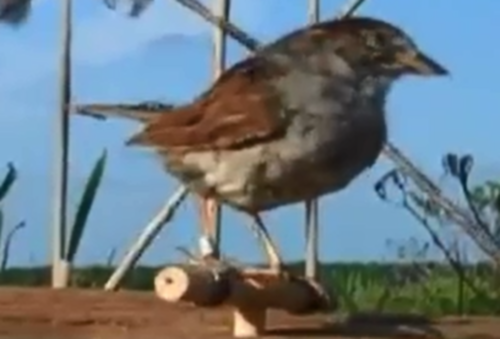Researchers at Duke University recently took a major step toward better understanding how swamp sparrows use a combination of song and visual displays to communicate with one another.

(Image via birdsasart.com)
How they came about making this discovery, though, is what makes this story particularly newsworthy — they stuffed a deceased swamp sparrow with a miniature computer and some robotics to give it the ability to flap its wings as if it were alive.
Duke biologist Rindy Anderson led a team of biologists on the study, receiving technical assistance from engineering undergraduate student David Perch. The team brought “Robosparrow,” as it is aptly referred to, to a swamp sparrow breeding ground and placed it in the territories of live males.

Robosparrow sitting in the swamp sparrow breeding ground.
Once all systems were go, the robotic bird “sang” swamp sparrow songs vis-à-vis a nearby sound system that let the birds know it was intruding on their ground. Anderson observed from a distance, sitting amid the tall swampy grasses, and changed the bird’s behavior to study various responses. They had it sing in a stationary position, shift side to side, and as mentioned before, flap its wings.
What they found was a song combined with wing waves is more potent than song alone, and that wing waves by themselves evoked the most aggressive response from live male birds.
“What I didn’t expect to see was that the birds would give strikingly similar aggressive wing-wave signals to the three types of invaders,” Anderson said. That is to say, she thought the defending birds would simply match the signals of the intruding robosparrow. What they instead discovered was that the males are more individualistic and consistent in the level of aggressiveness that they want to signal.
“That response makes sense, in retrospect, since attacks can be devastating,” she said. What Anderson means by this is that male swamp sparrows only want to signal a certain level of aggression to see if they can scare off an intruder without provoking any sort of physical conflict that could result in severe injury or death. Some sparrows were intimidated by robosparrow’s flapping, while others responded with a more aggressive flapping pattern.
Also worth noting from this study is that whether the robosparrow waved its wings or not, some live male sparrows still came in and attacked it. “It's high stakes for these little birds. They only live a couple of years, and most only breed once a year, so owning a territory and having a female is high currency,” Anderson said.
Looking ahead, Anderson and her team plan to further test how the sparrows use wing waves combined with a characteristic twitter called “soft-song” to show aggression and fend off competition. Unfortunately, it’s going to take some time before the bot gets back in the field, as robosparrow’s motor is burned out from its last run, and the bird’s head was ripped off during one of the attacks.
You can download Anderson’s article “Male response to an aggressive visual signal, the wing wave display, in swamp sparrows.” It was published in the journal Behavioral Ecology and Sociobiology and is available for purchase.
Share your thoughts on this new technology in the power solutions community on DigiKey’s TechXchange.
Story via: duke.edu
Advertisement





